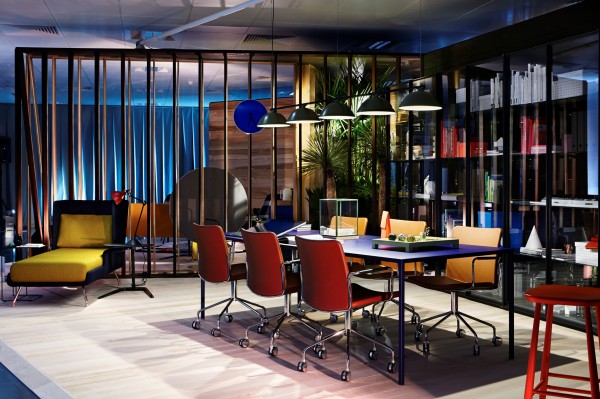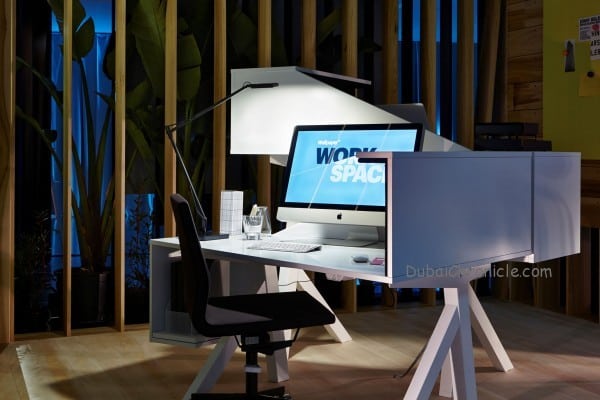Adam Khan and Wallpaper collaborate with AHEC to develop a striking timber composition – ‘Octopus’
The American Hardwood Export Council (AHEC), the leading international trade association for the American hardwood industry, is showcasing the ‘office of the future’ at the Wallpaper Handmade Exhibition, which opened today (April 9, 2013) as part of Salone del Mobile in Milan. AHEC was invited to collaborate with Wallpaper and architect Adam Khan to rethink the modern workplace and present a radical new vision of how and where we should spend our working lives. The result is a striking timber striking timber composition, ‘Octopus’, which defines, divides and connects various work zones and a section of this is being displayed at the Leclettico Gallery until April 13.
Working closely with UK-based sculptor and fabricator Adam Kershaw, Khan has created ‘Octopus’, which combines natural and heat-treated American tulipwood with American maple flooring in his design to create a warm, rich work environment. According to Khan, the space was designed for a generic open-floor plan to concentrate the space around it. The piece hovers between furniture and construction and the spaces are defined by veil-like layers of light and dark fine tulipwood. In addition, the natural color variations in the tulipwood create a dramatic marbled effect, which contrasts with the dark heat-treated timber, a material designed for exterior use but also used internally to provide a darker finish.
“AHEC’s participation at Salone del Mobile follows an extremely successful showing of ‘Octopus’ at Howick Place in London in March this year. Whilst we are only showcasing a section of the entire structure, we are confident that visitors will appreciate the beauty of Adam Khan’s design, which incorporates American tulipwood and hard maple, and aims to present a new vision of how and where we should spend our working lives. This unique commission has allowed us to further our research into contemporary lifestyles and working conditions whilst highlighting the beauty and natural variation of American hardwoods,” said Roderick Wiles, AHEC Director for Africa, Middle East, India and Oceania.
The project also involved Adam Kershaw, whose role as the fabricator was to maintain the visual simplicity. According to Kershaw: “Adam Khan’s structure is simple to the eye but was complex to make. The walls appear to be standing unsupported but are held up by the central sub floor and ceiling which help to create a solid structure.” Aside from the structural complexity, a high number man-hours were required to achieve the seamless finish. The finished structure consists of 179 vertical pieces and each one was sanded and finished by hand, totaling 3km of edges and 6km of corners to sand.
Robert Morgan from Morgan Timber, who supplied the material, was delighted that Khan chose to use tulipwood. Morgan states: “Tulipwood is commonly used for internal joinery in the UK and is very suitable for doors, linings and mouldings. It is unusual to use tulipwood without painting but the results can be striking. The color variations, patterns and streaks in the heartwood contrast with the creamy sapwood to produce a very interesting effect which is beautifully exploited in this workspace cladding.” According to Morgan, the American hard maple flooring highlights the color and grain of the tulipwood. He adds, “Hard maple is a tough and strong timber, often used in hard-wearing flooring applications such as sports halls and gymnasiums. In a market dominated by white oak, it is a pleasure to demonstrate an alternative flooring solution. Perhaps a renaissance is on the cards for this fine wood.”
“Wallpaper has once again assembled an international cast of star designers, craftsmen and makers to create perhaps the blockbusting show of the week. By showcasing Adam Khan’s design, we hope to raise awareness of thermally-modified American hardwoods, which have tremendous potential in both established markets as well as in developing ones. Somewhat limited availability may be a constraining factor for the immediate future, but this is changing very quickly, as producers adopt the technology across the United States, Canada and also in Europe and Asia. Its consistent rich brown color, its dimensional stability, resistance to decay and its environmental credentials all point to it being one of the most exciting new products the wood industry has been able to offer in recent years,” concluded Wiles.





































